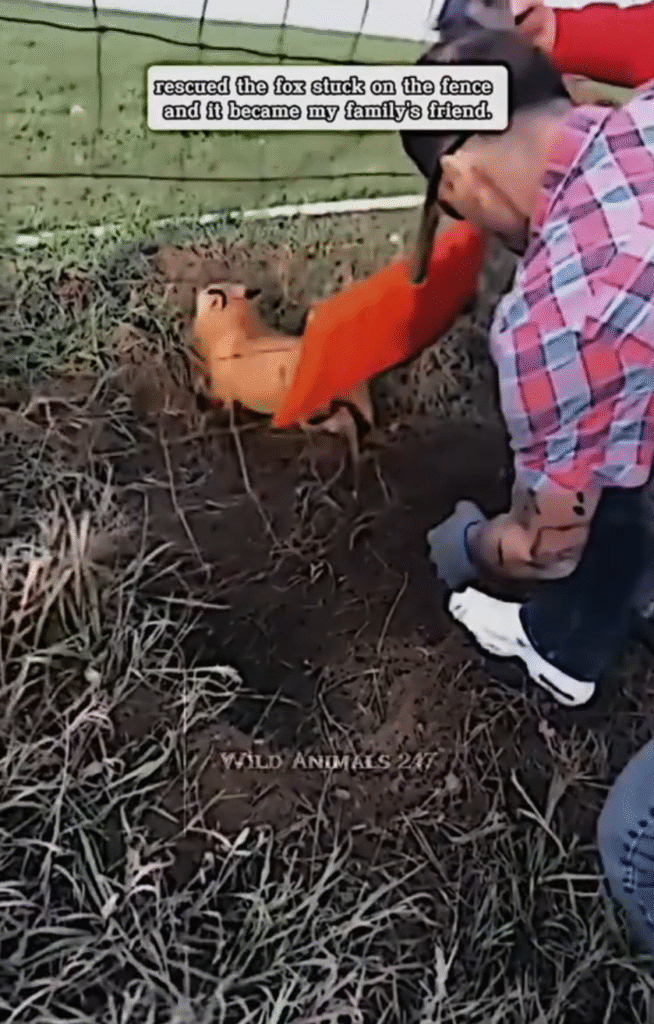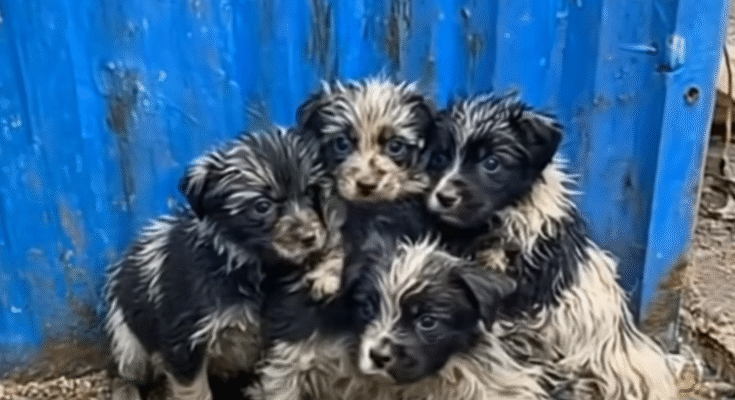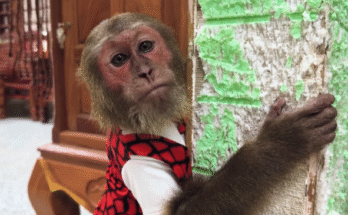It was just past dawn when I heard the first sound—an odd, desperate yelp echoing across the edge of my backyard. At first, I thought it might be a stray dog or perhaps a bird caught in something, but the sound was too sharp, too strained. I pulled on my boots, grabbed a flashlight, and followed the noise toward the wooden fence that bordered the nearby woods.
As I got closer, I saw it: a young red fox, its back leg horribly twisted and caught in the wire mesh at the top of the fence. Its fur was matted, its eyes wide with fear. It must’ve tried to leap over the fence and miscalculated, leaving it dangling helplessly.
I froze for a second, unsure what to do. The fox was clearly in pain, but it thrashed whenever I got near. I didn’t want to hurt it more—or risk getting bitten. Still, I couldn’t just leave it there. I ran back to my shed, grabbed a thick towel, some gloves, and a pair of wire cutters. This wasn’t my first animal rescue—I’d helped a raccoon caught in a storm drain and once saved a squirrel tangled in fishing line. But this fox was in another league of distress.

When I returned, the fox had grown quieter, exhausted from its struggle. I slowly approached, speaking softly. “It’s okay, I’m here to help you.” It stared at me, tense but no longer jerking away. I wrapped the towel gently around its upper body, shielding its teeth from me while trying to comfort it. Then, using the wire cutters, I carefully snipped away the sharp pieces of mesh around its leg. It took time—almost twenty minutes—but finally, with one last snip, the fox slid free and collapsed into the towel in my arms.
I could feel its small body trembling. Blood trickled from the cut on its leg, and its breathing was shallow. It needed help beyond what I could give. I carried it to the car and drove straight to the wildlife rehabilitation center two towns over. Every bump on the road made me flinch, hoping I wasn’t making things worse.
When I arrived, the staff rushed the fox inside. I explained everything—where I’d found it, how long it had been stuck, and what I’d done to free it. They nodded, taking notes and assuring me they’d do everything they could. They asked if I wanted to be updated. I said yes, of course. I felt responsible.
The next few days passed in a strange mix of anxiety and hope. I kept checking my email and phone, waiting for news. On the fourth day, I got the message: “The fox is stable. Injuries to the leg were significant but not life-threatening. She’s eating well and starting to trust the caretakers. She’ll stay in our care for a few more weeks until she can be released back into the wild.”
Relief washed over me. I hadn’t realized how invested I’d become in this fox’s fate. I asked if I could visit, and to my surprise, they agreed.
When I arrived at the center, a kind volunteer led me to a quiet area where the fox rested in a roomy enclosure. She was cleaner now, her leg bandaged but healing. She perked up when she saw me, tilting her head slightly, as if she remembered.
“She’s doing really well,” the volunteer said. “We call her Ember.”
Ember. It suited her. Fiery red fur, burning spirit.
From then on, I visited Ember weekly. I never touched her—she was a wild animal, after all—but I sat nearby and watched her grow stronger. She limped less each time I came. She began to play with toys in her enclosure. Sometimes, she even dozed off while I was there.
Eventually, the rehab center announced she was ready for release. They invited me to be part of it.
The release site was just beyond the woods near my home, the same area where I had found her. It felt right. The volunteers set the crate down, opened the door, and stepped back.
At first, Ember hesitated. Then, with a cautious step, she emerged, sniffing the air. She looked at me one last time—just a glance—and then darted off into the trees, her red tail a flash of fire through the green.
I stood there for a long time after she vanished, my heart full. I hadn’t just saved a fox. I’d become part of her story. And she had become part of mine.
But that wasn’t the end.
About two months later, I was walking through the same stretch of woods, just before sunset, when I heard a soft rustle in the bushes. I paused, thinking it might be a rabbit or deer. Instead, out stepped a young fox—Ember.
I recognized her instantly, though she had filled out and now moved with graceful ease. She didn’t run from me. She stood still, ears twitching, watching. I slowly crouched down, not moving too close.
After a moment, she trotted forward a few steps, then paused again, almost like she was showing me something. I followed her, keeping a respectful distance. She led me to a small den, half-hidden under a fallen log. And that’s when I saw them—two tiny fox kits, tumbling in the grass.
My breath caught.
Ember had become a mother.
She looked back at me one last time, then returned to her young, curling up around them protectively. I backed away, tears stinging my eyes. This was her world now, and she was thriving in it.
The story spread through my small town. “The fox that came back.” People began to talk more about wildlife, about building safer fences, about protecting the animals we shared our space with. Some neighbors even installed small wildlife crossings on their properties. Kids painted signs reminding people to slow down while driving near the woods.
All because one fox got stuck on a fence, and someone decided to help.
And Ember? She remained a quiet guardian of the woods. I didn’t see her often, but every now and then, I’d catch a glimpse of her red fur in the distance—or hear the playful yips of her kits echoing through the trees.
Rescuing Ember wasn’t just about saving her. It was about discovering the impact one act of kindness can make—and how the smallest lives can leave the biggest mark.



